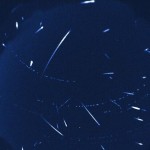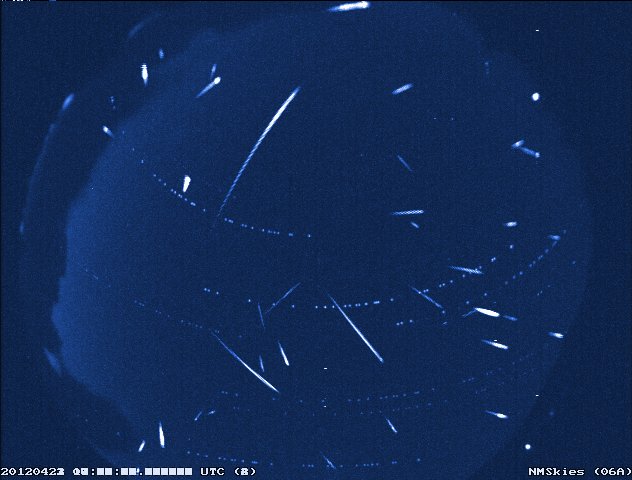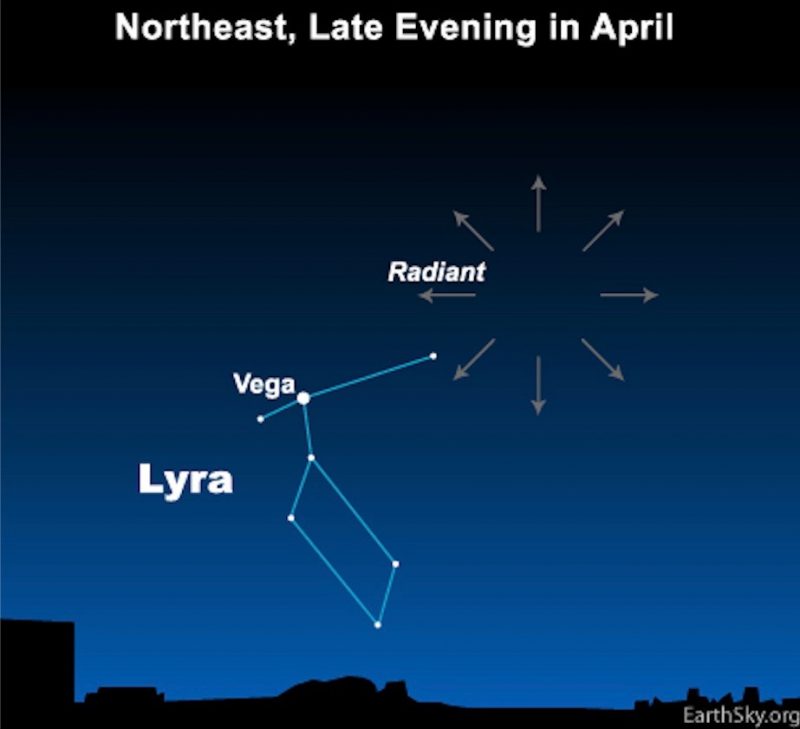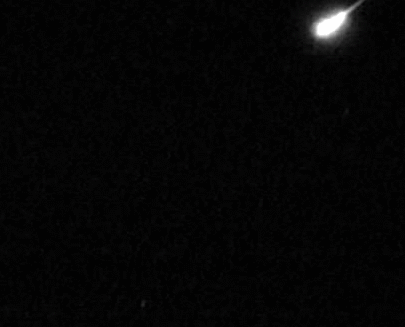

Composite image of Lyrid and not-Lyrid meteors over New Mexico from April, 2012. Image via NASA/MSFC/Danielle Moser.
The annual Lyrid meteor shower is active each year from about April 16 to 25. In 2020, we expect the shower to pick up beginning late at night on Sunday, April 19, 2020, probably peaking in the predawn hours on Wednesday, April 22. The follow morning (April 23) might be good too, if you’re game. This shower comes after a months-long meteor drought that always falls between early January and April’s Lyrid shower each year. There are no major meteor shower during those months, as you can see by looking at EarthSky’s meteor shower guide. By April, many meteor-watchers are itching to get going! So – though they produce only 10 to 15 meteors per hour at their peak – the Lyrids are always welcome!
No matter where you are on Earth, the best time to watch is between midnight and dawn. You’ll want to watch in a dark country sky. Keep reading to find some tips for watching the 2020 Lyrids.
Tip #1: Learn about this shower’s radiant point. If you trace the paths of all the Lyrid meteors backward, they seem to radiate from the constellation Lyra the Harp, near the brilliant star Vega. This is only a chance alignment, for these meteors burn up in the atmosphere about 60 miles (100 km) up. Meanwhile, Vega lies trillions of times farther away at 25 light-years.
Yet it’s from Vega’s constellation Lyra that the Lyrid meteor shower takes its name.

Lyrid meteors radiate from near the bright star Vega in the constellation Lyra the Harp. You don’t need to identify Vega or Lyra in order to watch the Lyrid meteor shower. The meteors radiate from there, but will appear unexpectedly, in any and all parts of the sky.
All you need to know about a meteor shower’s radiant point is its rising time. That’s because the shower starts (for the most part) after the radiant rises. It’s best (generally speaking) when the radiant is highest in the sky. Around the Lyrids’ peak, Vega rises – in the northeast – around 9 to 10 p.m. local time (the time on your clock, from all Northern Hemisphere locations). It climbs upward through the night, is fairly high by midnight, and is highest just before dawn.
That doesn’t mean you should rule out the late evening hours, though. Late evening might be the best time to catch an earthgrazer, which is a slow-moving and long-lasting meteor that travels horizontally across your sky.
Tip #2: Observe from the country, away from city lights.
Tip #3: Don’t expect too much. A wise man once said:
Meteor showers are like fishing. You go. You enjoy the night air and maybe the company of friends. Sometimes you catch something.
Note for Southern Hemisphere observers: Because this shower’s radiant point is so far north on the sky’s dome, the star Vega rises only in the hours before dawn, for you. It’ll be lower in the sky for you than for us farther north on Earth’s globe, when dawn breaks. That’s why you’ll see fewer Lyrid meteors. Still, you might see some!

A fireball meteor falling earthward, courtesy of Wikipedia/NASA / George Varros. During a meteor shower, earthgrazer fireballs are most often seen in the early part of the night.
Here are some other cool facts about the Lyrids.
The Lyrids have been known to have outbursts. For example, in 1982, American observers saw an outburst of nearly 100 Lyrid meteors per hour. Japanese observers saw around 100 meteors per hour in 1945, and Greek observers saw that number in 1922. No Lyrid outburst is predicted for 2020, but you never know.
About a quarter of Lyrid meteors leave persistent trains. A meteor train is an ionized gas trail that glows for a few seconds after the meteor has passed.
The Lyrid meteor shower has the distinction of being among the oldest of known meteor showers. Records of this shower go back for some 2,700 years. The ancient Chinese are said to have observed the Lyrid meteors falling like rain in the year 687 B.C. That time period in ancient China, by the way, corresponds with what is called the Spring and Autumn Period (about 771 to 476 B.C.), which tradition associates with the Chinese teacher and philosopher Confucius, one of the first to espouse the principle:
Do not do to others what you do not want done to yourself.
I wonder if Confucius saw any Lyrid meteors … it’s possible!
Comet Thatcher (C/1861 G1) is the source of the Lyrid meteors. Every year, in late April, our planet Earth crosses the orbital path of this comet. We have no photos of it because its orbit around the sun is roughly 415 years. Comet Thatcher last visited the inner solar system in 1861, before the photographic process became widespread. This comet isn’t expected to return until the year 2276.
Bits and pieces shed by this comet litter its orbit and bombard the Earth’s upper atmosphere at 110,000 miles per hour (177,000 km/h). The vaporizing debris streaks the nighttime with medium-fast Lyrid meteors.
It’s when Earth passes through an unusually thick clump of comet rubble that an elevated number of meteors can be seen.

Comet Thatcher on January 1, 1861, the year of its last (and only) observed return. Image via JPL Small-Body Database.
Bottom line: The Lyrid meteor shower offers 10 to 15 (or so) meteors per hour at its peak on a moonless night. There will be little to no moon to spoil the show in 2020. We expect the shower to pick up beginning late at night on Sunday, April 19, 2020, probably peaking in the predawn hours on Wednesday, April 22. The follow morning (April 23) might be good too, if you’re game.
EarthSky’s meteor shower guide for 2020
from EarthSky https://ift.tt/2XEslkU


Composite image of Lyrid and not-Lyrid meteors over New Mexico from April, 2012. Image via NASA/MSFC/Danielle Moser.
The annual Lyrid meteor shower is active each year from about April 16 to 25. In 2020, we expect the shower to pick up beginning late at night on Sunday, April 19, 2020, probably peaking in the predawn hours on Wednesday, April 22. The follow morning (April 23) might be good too, if you’re game. This shower comes after a months-long meteor drought that always falls between early January and April’s Lyrid shower each year. There are no major meteor shower during those months, as you can see by looking at EarthSky’s meteor shower guide. By April, many meteor-watchers are itching to get going! So – though they produce only 10 to 15 meteors per hour at their peak – the Lyrids are always welcome!
No matter where you are on Earth, the best time to watch is between midnight and dawn. You’ll want to watch in a dark country sky. Keep reading to find some tips for watching the 2020 Lyrids.
Tip #1: Learn about this shower’s radiant point. If you trace the paths of all the Lyrid meteors backward, they seem to radiate from the constellation Lyra the Harp, near the brilliant star Vega. This is only a chance alignment, for these meteors burn up in the atmosphere about 60 miles (100 km) up. Meanwhile, Vega lies trillions of times farther away at 25 light-years.
Yet it’s from Vega’s constellation Lyra that the Lyrid meteor shower takes its name.

Lyrid meteors radiate from near the bright star Vega in the constellation Lyra the Harp. You don’t need to identify Vega or Lyra in order to watch the Lyrid meteor shower. The meteors radiate from there, but will appear unexpectedly, in any and all parts of the sky.
All you need to know about a meteor shower’s radiant point is its rising time. That’s because the shower starts (for the most part) after the radiant rises. It’s best (generally speaking) when the radiant is highest in the sky. Around the Lyrids’ peak, Vega rises – in the northeast – around 9 to 10 p.m. local time (the time on your clock, from all Northern Hemisphere locations). It climbs upward through the night, is fairly high by midnight, and is highest just before dawn.
That doesn’t mean you should rule out the late evening hours, though. Late evening might be the best time to catch an earthgrazer, which is a slow-moving and long-lasting meteor that travels horizontally across your sky.
Tip #2: Observe from the country, away from city lights.
Tip #3: Don’t expect too much. A wise man once said:
Meteor showers are like fishing. You go. You enjoy the night air and maybe the company of friends. Sometimes you catch something.
Note for Southern Hemisphere observers: Because this shower’s radiant point is so far north on the sky’s dome, the star Vega rises only in the hours before dawn, for you. It’ll be lower in the sky for you than for us farther north on Earth’s globe, when dawn breaks. That’s why you’ll see fewer Lyrid meteors. Still, you might see some!

A fireball meteor falling earthward, courtesy of Wikipedia/NASA / George Varros. During a meteor shower, earthgrazer fireballs are most often seen in the early part of the night.
Here are some other cool facts about the Lyrids.
The Lyrids have been known to have outbursts. For example, in 1982, American observers saw an outburst of nearly 100 Lyrid meteors per hour. Japanese observers saw around 100 meteors per hour in 1945, and Greek observers saw that number in 1922. No Lyrid outburst is predicted for 2020, but you never know.
About a quarter of Lyrid meteors leave persistent trains. A meteor train is an ionized gas trail that glows for a few seconds after the meteor has passed.
The Lyrid meteor shower has the distinction of being among the oldest of known meteor showers. Records of this shower go back for some 2,700 years. The ancient Chinese are said to have observed the Lyrid meteors falling like rain in the year 687 B.C. That time period in ancient China, by the way, corresponds with what is called the Spring and Autumn Period (about 771 to 476 B.C.), which tradition associates with the Chinese teacher and philosopher Confucius, one of the first to espouse the principle:
Do not do to others what you do not want done to yourself.
I wonder if Confucius saw any Lyrid meteors … it’s possible!
Comet Thatcher (C/1861 G1) is the source of the Lyrid meteors. Every year, in late April, our planet Earth crosses the orbital path of this comet. We have no photos of it because its orbit around the sun is roughly 415 years. Comet Thatcher last visited the inner solar system in 1861, before the photographic process became widespread. This comet isn’t expected to return until the year 2276.
Bits and pieces shed by this comet litter its orbit and bombard the Earth’s upper atmosphere at 110,000 miles per hour (177,000 km/h). The vaporizing debris streaks the nighttime with medium-fast Lyrid meteors.
It’s when Earth passes through an unusually thick clump of comet rubble that an elevated number of meteors can be seen.

Comet Thatcher on January 1, 1861, the year of its last (and only) observed return. Image via JPL Small-Body Database.
Bottom line: The Lyrid meteor shower offers 10 to 15 (or so) meteors per hour at its peak on a moonless night. There will be little to no moon to spoil the show in 2020. We expect the shower to pick up beginning late at night on Sunday, April 19, 2020, probably peaking in the predawn hours on Wednesday, April 22. The follow morning (April 23) might be good too, if you’re game.
EarthSky’s meteor shower guide for 2020
from EarthSky https://ift.tt/2XEslkU


Aucun commentaire:
Enregistrer un commentaire